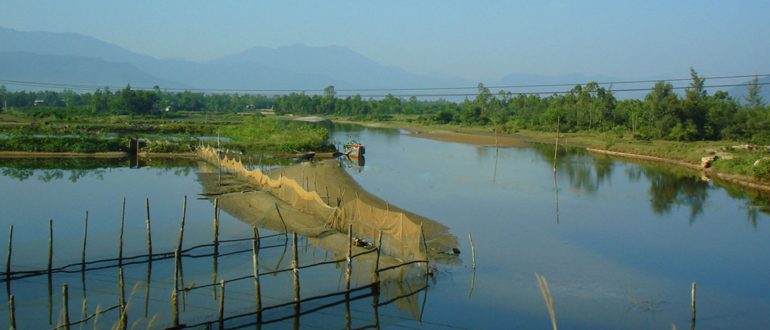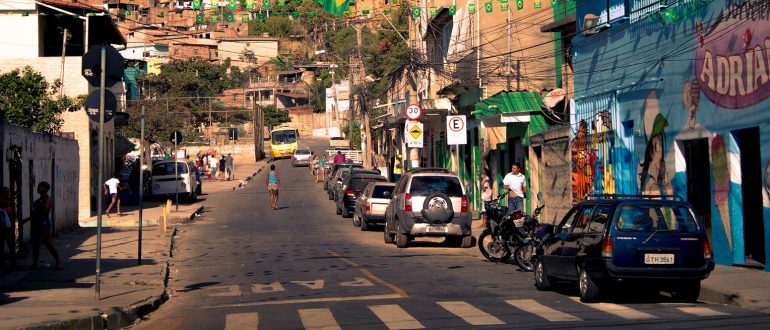
Strategies for sustainable shrimp aquaculture in Vietnam: The example of integrated shrimp-mangrove farming and organic certification
Rapid expansion of shrimp aquaculture in Vietnam has raised serious environmental and social challenges. This essay introduces two strategies in shrimp production, first a model of integrated shrimp-mangrove farming and second organic certification processes, and looks at their potential of being a sustainable option for future shrimp aquaculture in Vietnam.
Shrimp are consumed as one of the most favourite sea food throughout the world. The coastal areas of Southeast Asia have become major producers of shrimp aquaculture, dominating the world market for the last four decades (Ha et al. 2012b). Especially in the Mekong Delta in Vietnam, conditions for shrimp farming are favourable due to the region’s year-round tropic climate, fertile soil and diverse mangrove forests. It also locates about 75% of the country’s shrimp production (Lan 2013). While the coastal communities in Southern Vietnam have profited considerably from the rise in shrimp aquaculture, the rapid expansion has led to serious environmental and social challenges. Problems such as soil and water pollution, salt water intrusion, contamination with antibiotics and the loss of mangrove forests threaten peoples’ livelihoods and the ecosystem (Lan 2013). This essay introduces two strategies in shrimp production to look at their potential of being a sustainable option for future shrimp aquaculture in Vietnam. Starting with a model of integrated shrimp-mangrove farming, the paper will continue evaluating organic certification processes.
Integrated shrimp-mangrove farming
The expansion of shrimp aquaculture is one of the major reasons for the loss of mangrove forests, which are sensitive yet highly valuable ecosystems. However, as mangrove forests do in fact strongly enhance quality of shrimp production, a strategy of integrating mangrove protection and shrimp farming has been promoted since the beginning of shrimp aquaculture in the 1980s (Ha et al. 2012b; Binh et al. 1997).
Mangrove forests serve a number of ecological functions with direct and indirect effects on the sustainability and stability of shrimp aquaculture. For example, mangrove forests increase biodiversity of plankton or fish, improve water quality and lower the risk for diseases of shrimp and fish. Thus, not only shrimp yield is improved but also the risk of highly variable shrimp yields can be reduced by diversification into other aquatic products. Similarly, mangroves protect coastal areas from storms or erosion, function as carbon storages, and in addition, are a source for firewood or housing material (Johnston et al. 2000; McNally et al. 2010; Ha et al. 2012b). A comparison of productivity between extensive shrimp-mangrove systems and intensive shrimp-only farms shows that productivity is about the same level, indicating that integrated systems are highly economically efficient and reduce economic barriers to forested ponds (Ha et al. 2012b). An integrated system thus seems to be a key to improving both ecological conditions and livelihoods of farmers.
Although the benefits of integrated shrimp-mangrove aquaculture are recognized, implementation has been poor due to ineffective regulation and a lack of economic incentives (Ha et al. 2012b). Forest land in southern Vietnam is mostly controlled by state-owned companies and only subcontracted to farmers who are excluded from benefit sharing and management decisions (Ha et al. 2012b). However, as Ha et al. (2012b) indicate, farmers do recognise the significance of mangrove protection for long-term farming success and would willingly engage in mangrove maintenance as long as they were provided with full rights and responsibility over the management of their lands. Economic incentives for mangrove protection would also be given since forests have low income opportunities compared to shrimp-farming. Such devolution of rights in forest management thus would support sustainable farming practices and improve farmers’ livelihoods by raising and stabilising income and increasing participation.
Organic certification
A further approach to reduce vulnerability of farmers and enhance sustainability of aquaculture is the shift to certified organic production. In the Mekong Delta, organic standards are set by the German Naturland organisation. Due to its success in terms of environmental, social and economic development in some provinces, the government of Vietnam plans to extend organic certification to all farms with integrated shrimp-mangrove production (Ha et al. 2012a).
Integrated shrimp-mangrove farming systems provide a good basis for organic production as they are already built on ideas of bio-diversity and social sustainability (Ha et al. 2012a). However, against its implications of sustainability and support for small-holder farms, the certification scheme falls short of several key aspects. Most importantly, it neglects social and economic dimensions of production. Farmers are not adequately provided with market incentives such as access to markets and premium prices to shift to organic production. In addition, they cannot participate in decision making and have low negotiating power (Vandergeen 2007; Ha et al. 2012a). The current structure of the certification scheme even poses the risk to exclude small-holder farms from certification as it creates barriers to market entry, such as the costs for certification that have to be borne by farmers (Vandergeen 2007).
A certification scheme that successfully improves environmental, social and economic sustainability therefore must be able to deal with the fragmented structure of aquaculture in Vietnam (Tran et al 2013). Anh et al. (2011) suggest that cooperatives at the community level could help to increase bargaining power within the certification scheme and increase production efficiency and quality. To improve organisational power, cooperatives could further be integrated in clusters. However, since cooperatives and even clusters are still in danger to be marginalized due to a lack of financial and technical means, they must be specifically supported and included in regulation processes by local governments (Anh et al. 2011, Ha et al. 2012a).
Shrimp farming is widely contested due to its economic significance for producers on the one hand and its environmental impacts on the other. The constant demand for shrimp in the world makes it necessary, however, to think about sustainable long-term solutions. As this essay has shown for Vietnam, sustainable shrimp farming is basically possible: Integrating mangrove protection in farms and applying to organic production standards has positive impacts on social, economic and environmental conditions of production. Still, both strategies are not fully developed yet and tend to marginalise small-holder farms instead of integrating them. Knowledge, participation in decision making, and economic incentives need to be improved to foster sustainable production. If farmers, as well as all other stakeholders, had equal power and opportunities to negotiate their needs and rights, it would seem possible that shrimp aquaculture could benefit both the society and the environment.
References
Anh, Pham Thi; Bush, Simon R.; Mol, Arthur P.J.; Kroeze, Carolien (2011): The Multi-Level Environmental Governance of Vietnamese Aquaculture: Global Certification, National Standards, Local Cooperatives. In: Journal of Environmental Policy & Planning 13 (4), p. 373–397.
Binh, C. T.; Phillips, M. J.; Demaine, H. (1997): Integrated shrimp-mangrove farming systems in the Mekong delta of Vietnam. In: Aquac Research 28 (8), p. 599–610.
Ha, Tran Thi Thu; Bush, Simon R.; Mol, Arthur P.J.; van Dijk, Han (2012): Organic coasts? Regulatory challenges of certifying integrated shrimp–mangrove production systems in Vietnam. In: Journal of Rural Studies 28 (4), p. 631–639.
Ha, Tran Thi Thu; van Dijk, Han; Bush, Simon R. (2012): Mangrove conservation or shrimp farmer’s livelihood? The devolution of forest management and benefit sharing in the Mekong Delta, Vietnam. In: Ocean & Coastal Management 69, p. 185–193.
Johnston, Danielle; van Trong, Ngyuen; van Tien, Doan; Xuan, Tran Thanh (2000): Shrimp yields and harvest characteristics of mixed shrimp–mangrove forestry farms in southern Vietnam: factors affecting production. In: Aquaculture 188 (3-4), p. 263–284.
Lan, Ngo Thi Phuong (2013): Social and ecological challenges of market-oriented shrimp farming in Vietnam. In: SpringerPlus 2, p. 675.
McNally, Richard; McEwin, Angus; Holland, Tim (2010): The potential for mangrove carbon projects in Viet Nam. Hg. v. SNV.
Tran, Nhuong; Bailey, Conner; Wilson, Norbert; Phillips, Michael (2013): Governance of Global Value Chains in Response to Food Safety and Certification Standards: The Case of Shrimp from Vietnam. In: World Development 45, p. 325–336.
Vandergeest, Peter (2007): Certification and Communities: Alternatives for Regulating the Environmental and Social Impacts of Shrimp Farming. In: World Development 35 (7), p. 1152–1171.[:]



